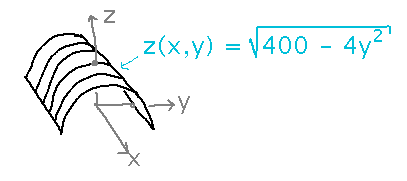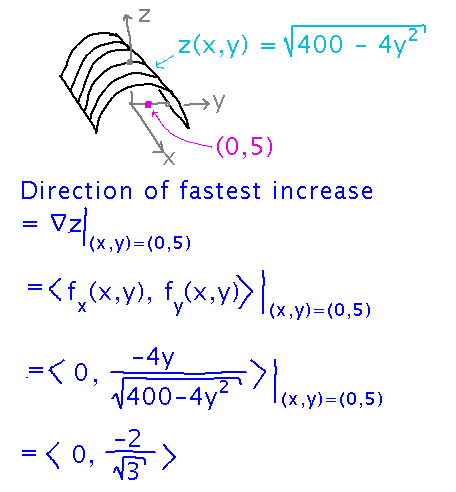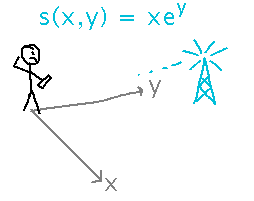Misc
PRISM Peer Advisement
Next Thursday, Oct. 25, 5:30 - 6:30, South 328.
Advice/talk from/with other students about the math major, course selection, gen ed, etc.
Questions?
Problem set 7 question 4? It doesn’t require you to explicitly find a tangent plane, although the equation for linear estimation is essentially the equation for a tangent plane.
Problem set 7 question 5? Estimate partial derivatives from the table.
Definitions
Section 4.6.
Field trip to Sturges Auditorium.
What is a directional derivative? The rate of change of a function as you move in a given direction through the space of its variables (e.g., through the xy plane for a function with variables x and y).
What is a gradient? There are several geometric interpretations of the gradient:
- The direction (in the space of variables) of greatest change
- The perpendicular to a level curve.
Gradient
Auditorium Example
Suppose Sturges Auditorium is a semi-circular tunnel, so the equation for the ceiling is z = √(400-4y2)

If you are standing at point (0,5), what direction should you walk in in order to have the height of the room over your head increase fastest?
Use the fact that the gradient points in the direction of greatest increase in the function’s value:

Note that this direction is towards the center of the auditorium, consistent with what you did when walking along gradients in the actual auditorium.
Cell Phone Example
Suppose you’re standing at point (0,0) in a cell phone signal “shadow” in which signal strength is given by s(x,y) = x ey. What direction should you walk in to get the fastest increase in signal strength?

Once again, use the fact that the gradient gives you the direction of greatest increase:

By how much will the signal strength increase per unit of distance you walk in that direction? Use the fact that the rate of change (i.e., the value of the directional derivative) in the gradient direction is the magnitude of the gradient:

Key Points
Calculate gradient as a vector of partial derivatives.
Definition/properties of the gradient.
Next
Some examples of directional derivatives.
Then local extreme values.
Guiding example: Where does the function f(x,y) = 10 - x2 - y2 + xy + 4x + 2 have its largest value?
Read these subsections of section 4.7:
- Critical Points
- Second Derivative Test